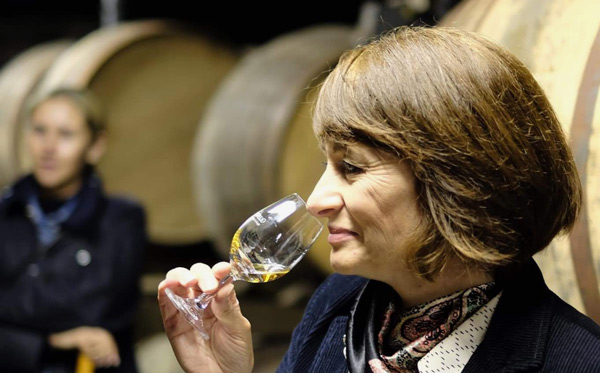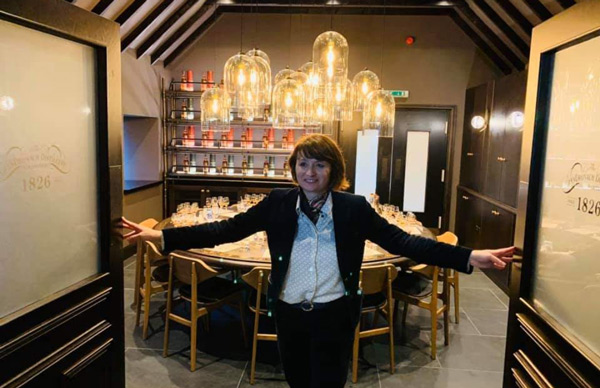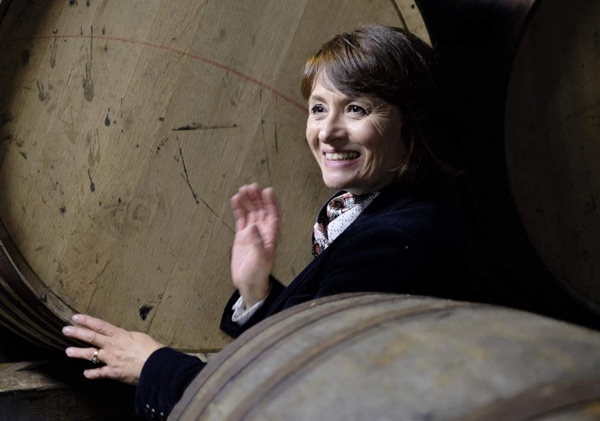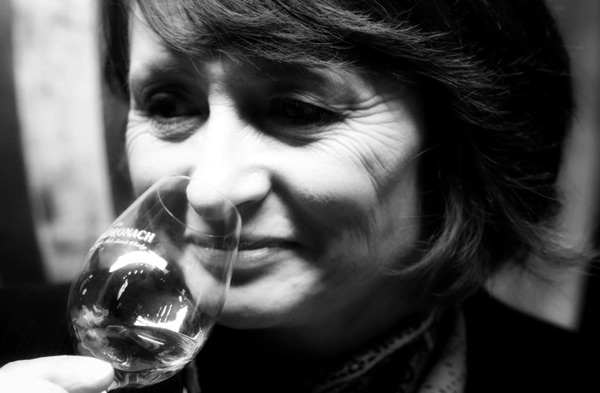
Rachel Barrie is one of the whisky industry’s greatest master blenders, having worked at many distilleries in Scotland. She has returned to her roots in the Scotland’s north-east, and is creating exquisite malts for Brown-Formans’ three single malt distilleries – GlenDronach, BenRiach and Glenglassaugh. Our ever-persistent whisky lass managed interrupt her busy schedule for a few questions…

” It’s a great time to be working in Whisky! “
JV: Rachel, when and where did your whisky journey kick off?
RB: It started with my Dad, at home in Aberdeenshire. He had a single malt collection that I was in awe of. On leaving home for Edinburgh University, I used to treat myself to a miniature of single malt every couple of weeks, as a reward for hard work, and soon tasting and collecting miniatures became a hobby. With an Honours degree in Chemistry, and unsure what to do next, I stumbled across a job on the last day it was advertised at the University of Edinburgh careers service, for a Research Scientist at the Scotch Whisky Research Institute (SWRI). Luckily, I got the job. This proved to be a pinnacle moment in defining the perfect job for me, combining analytics, honed through studying chemistry, with my passion for malt whisky. My focus was on oak maturation and distillery flavour development. During my time there, and moving on to work in production thereafter, I began to think about the role of Master Blender. Starting in my early twenties, I knew it would take time to acquire the knowledge, skills and experience to develop fully into this role.
JV: You must be extremely busy on a day to day basis, what does your daily routine look like?
RB: My day-to-day life is extremely varied. I check the quality of the distillate off the still for each distillery, manage the inventory and recipes for the coming years, select the casks and approve each vatting for bottling, create new whiskies for product development and limited editions, and manage the wood policy and procurement requirements for our three distilleries. On any day, I could be nosing whisky and writing tasting notes, planning the cask programmes for the year, and hand-selecting any of the 160 or so cask bottlings released per annum across the three distilleries. As well as whisky-making, I get the opportunity to travel for 5-6 weeks each year to all corners of the globe, spreading the word of GlenDronach, Benriach and Glenglassaugh.

JV: Are you the master blender for Glendronach, Benriach & Glenglassaugh?
RB: I am the Master Blender for The GlenDronach, BenRiach and Glenglassaugh distilleries in Speyside and the Highlands of Scotland. Working with these three distilleries in the North-East has been the perfect home-coming for me, and having worked with distilleries from the four corners of Scotland, I’ve now returned to my ‘roots’, where I was born and brought up. Within the geography of the North-East of Scotland, the distilleries are highly distinctive, with the flavour exploration of Benriach in the heart of Speyside, the sherry cask mastery of The GlenDronach in the valley of Forgue, and the luscious coastal influence at Glenglassaugh, in Sandend Bay. Each distillery paints a different picture, with unique influences of location, landscape and distillery process. A big part of my job is to understand,shape and nurture each character, and bring each to life through bespoke, considered maturation in quality oak casks.
JV: Do you visit all three distilleries in one day?
RB: It is possible but rare to visit all three distilleries in one day. The focus is on one distillery at a time. I’ve spent most time at GlenDronach and Benriach, followed by Glenglassaugh. In one day, it is more likely to go between Glendronach and Glenglassaugh or Benriach and Glenglassaugh, only a 20-25 minute drive apart. From Glendronach to Benriach takes double the time – the longest distance in the distilleries’ trinity.
JV: Which distilleries did you work for prior to the current distilleries?
RB: Over the past 28 years, I’ve worked with a great many distilleries, working on everything from selecting individual distillery cask bottlings, to including different distilleries in blend compositions whilst maintaining consistency. I’ve deep dived into stock profiles and distillery processes of about a dozen distilleries, fine-tuning process, selecting ingredients and developing the wood policy for maturation. The distilleries ranged from the Northern to Eastern Highlands, Speyside to the Lowlands, and as far west as the island of Islay. What continues to amaze me is how distillery location contributes so much to individuality of character and diversity of style.
At each of our 3 distilleries, barley is sourced locally from maltings in the North East of Scotland, and the barley, peat (when used), water, environment and warehousing conditions are as authentic as can be to each distillery location.

JV: How on earth do you manage consistency?
RB: Endless sampling and quality checking! Records of individual distillate and cask maturation quality are kept, including sensory profiles and colour measurements, especially as every whisky is of natural cask-imparted colour. It is a fascinating challenge to maintain consistency with such a natural product.
Decision-making around wood policy, new fill maturation plans, and stock requiring re-racking or ‘finishing’ is a daily occurrence. The goal is to continuously ‘raise the bar’ to deliver the ultimate quality, balance and complexity, true to character and house style.
One can never sample enough whisky! Maturation changes the spirit every day, and decision-making requires understanding and agility, not to mention, a lot of patience. As soon as one cask is sampled and analysed, the questions it raises triggers the need to sample others and the list keeps growing! Strategic inventory management and stock optimisation are certainly a positive challenge, although to make predictions, a crystal ball would come in handy!
JV: What is your most important asset, your nose or your palate?
RB: 90% of the appreciation of flavour comes from the aromatics, discerned on the nose. Once the nose is trained, it is the most important asset for a blender. The nose never gets tired of sniffing, and as there is no physiological impact, it is the most reliable measure of quality, with tremendous sensitivity and its strong connection with memory. The human nose has a tiny analytical sensor (the olfactory epithelium), with the ability to detect 10,000s of aromas, with odour recognition and descriptions developed through experience and training.
JV: Do you find it challenging being a woman in a male dominated industry?
RB: It has been wonderful to be part of the evolution and growth of diversity in the whisky industry. We have the most diverse and complex spirit in the world, and the industry now reflects this through its people. With a focus on skill, competence, collaboration and attitude, diversity and inclusion disrupts the norm to share fresh perspectives, find solutions, learn from each other, work together, innovate and break new ground.
JV: Do you think there is a bright future ahead for women in the spirits business, specifically the whisky industry?
RB: It’s a great time to be working in Whisky! With increasing diversity at work and in consumer demographics, the future is bright, and together, we will continue making great whisky and sharing it with the world.
JV: If you could give us one word for your style of blending, what would it be?
RB: Exploration.
JV: You have recently become a Keeper of the Quaich, what an amazing achievement as a woman, how did that make you feel?
RB: Being inducted as a Keeper of the Quaich made me feel a deep sense of gratitude and belonging, with the recognition that this will endure through generations. The society brings together those leading the way in Scotch whisky, and I am very thankful to be part of it.
JV: What was it like to work with Dr Jim Swan?
RB: Dr Jim Swan was my teacher and mentor, from whom I learned the science, the art and the ideas from which to deeply understand and make the best whisky possible. My time with Jim was a journey of learning and discovery, of research focused on questioning, and exploring flavour through detailed analysis, quality measurement, critical thinking, sensory perception and human understanding. When I think of Jim, ‘the nose ‘knows’’, a phrase I coined in recent years, springs to mind. He had a logical, analytical mind, balanced with a strong sense of intuition and sensory awareness, all qualities of a truly great Master Blender, with a ‘nose’ that really ‘knows’.
JV: Ending on a bit of a controversial note, why are current whisky expressions so notably different?
RB: Do you think they are different? Some people say they’re different, and some do not. Current expressions are receiving great accolades and winning international spirit awards, a testimony of the time spent crafting, selecting and perfecting. As a perfectionist and an explorer, I seek the ultimate balance of complexity, depth, integration and strength of character. My vision is for every expression to tell its own story, so the drinker can experience the ultimate journey of exploration, enlightenment and maturity.
The GlenDronach 12 celebrates the complexity of distillery character maturing in the ‘valley of the brambles’, rich and fruity, vinous yet spicy, mellow and creamy with a lingering nuttiness. GlenDronach 15 is the ultimate expression of the exquisite dark refinement that appears at 15 years old, with bittersweet dark chocolate, the darkest fruit and elegant lingering spices. GlenDronach 18 is bold and commanding, mature and full-bodied, with leather, walnut, tobacco leaf and intense dried fruit. Each expression is different, yet all are a true reflection of the rich complexity of The GlenDronach.
As you will see in 2020 and beyond, the journey of malt exploration is endless, and will endure for generations to come…

A big “Thank you” to Rachel for taking the time to answer our questions. We wish here every success!
